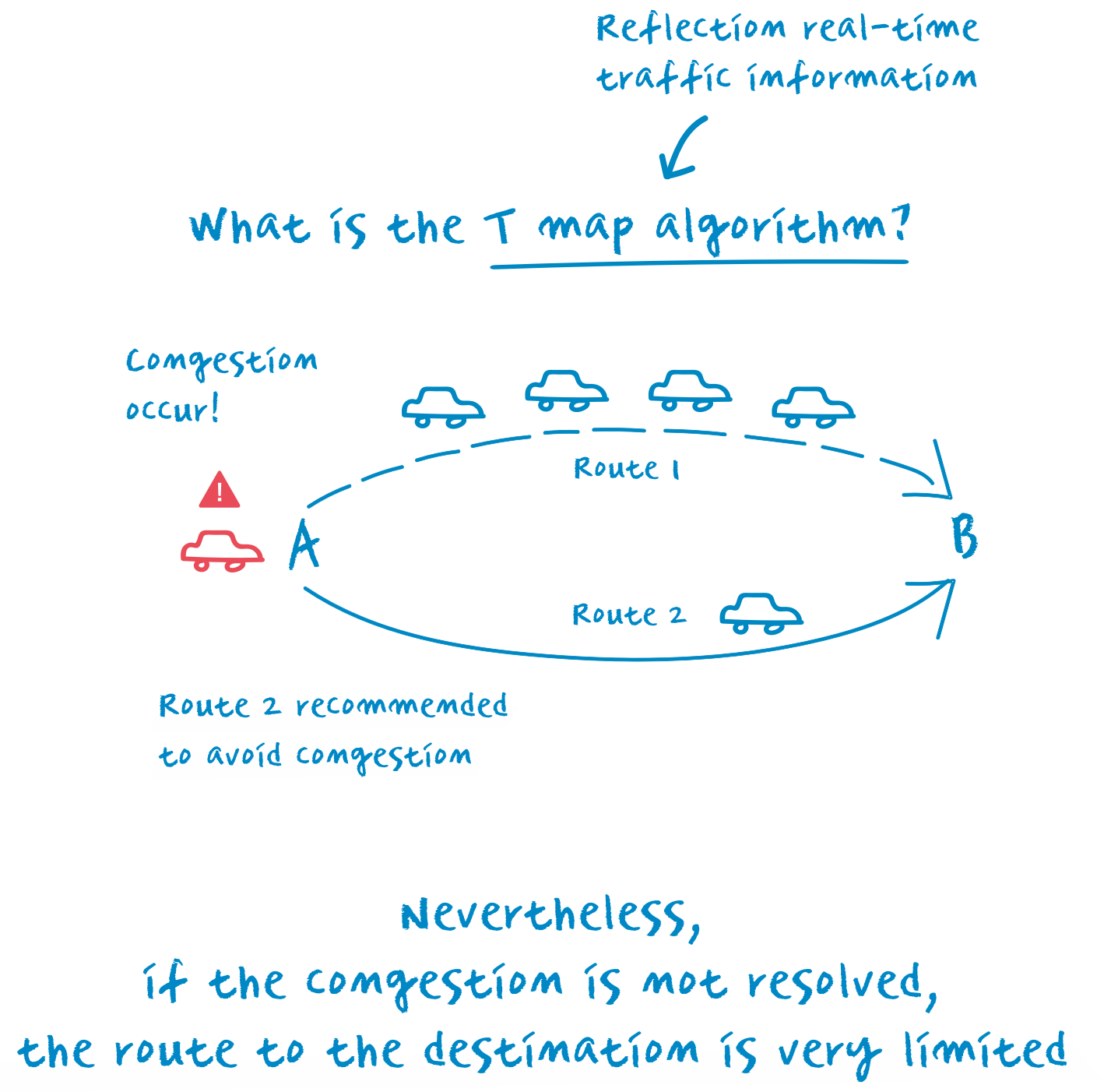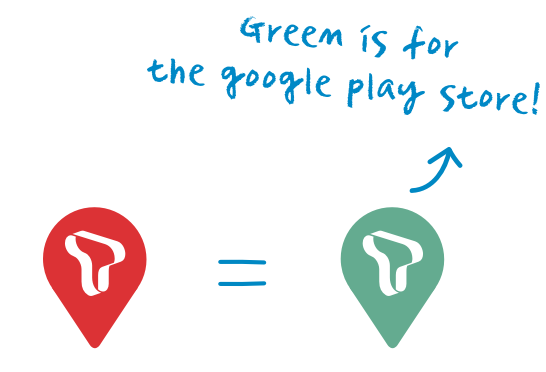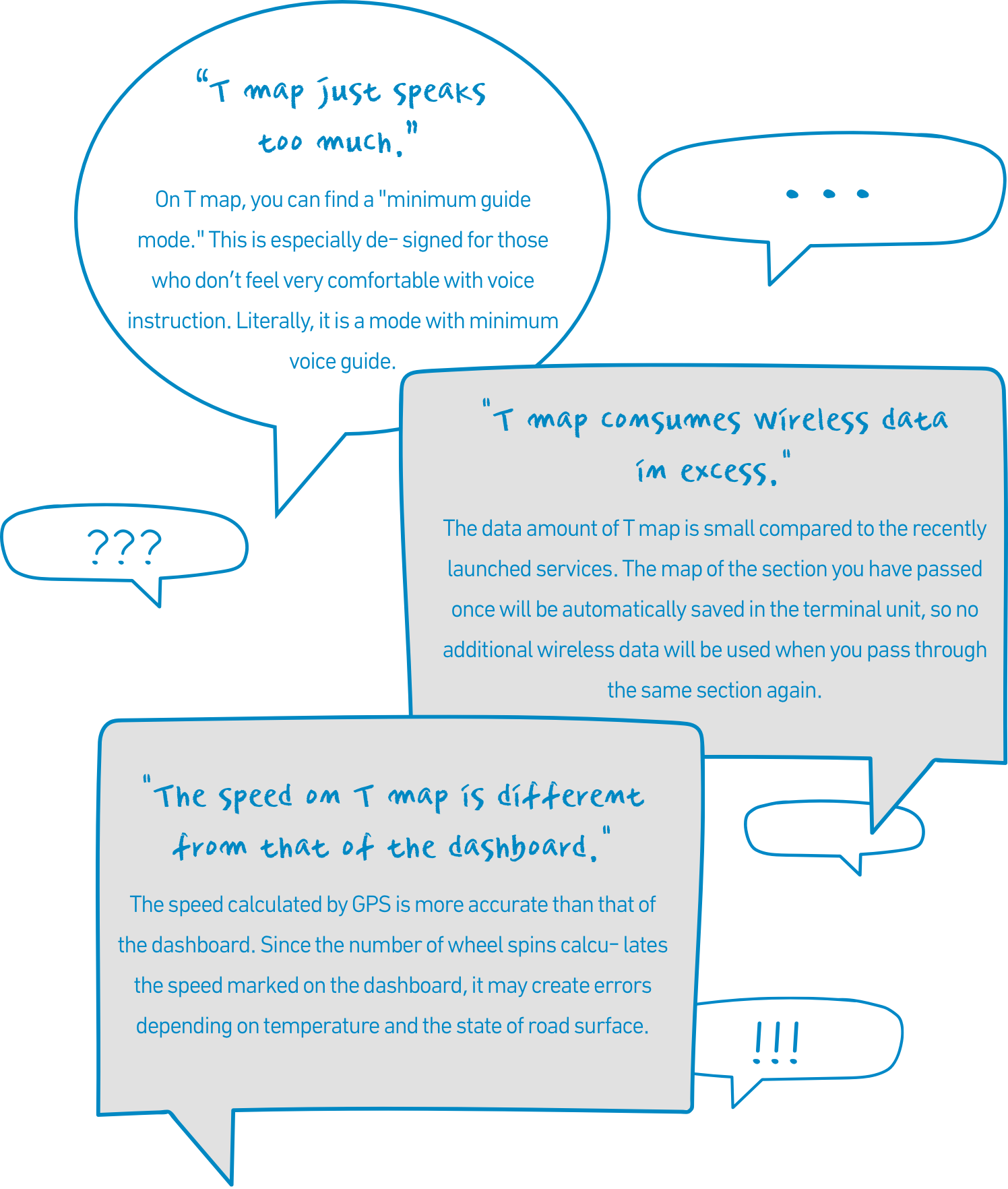
Inside T map
T map, true or false?
For the past ten years, T map has been considered the national navigation in line with wide distribution of smartphones. Over time, the number of monthly users exceeded 10 million, and it grew into a mega-platform used by about 13 million a month as of 2020. Consequently, users who actively share their T map experience on the wheel began to emerge and this participation of users contributed to improving quality of service of T map. However, some groundless "ghost story-like" suspicions or canards about T map started to spread. We will pick up some popular examples of these stories to rebut misunderstanding of T map. You be a judge. True or false?


Is it true that
T map is receiving money
from Gangnam beltway, the private road?
Most of roads are constructed and managed with the budget of the state or local
governments. At times, there are some roads operated based on private capital.
This kind of road is called a "private road" and it charges costly toll. We are aware
that users prefer to get information of the route avoiding private roads. However,
in some specific sections, there are no good alternative routes to recommend and
it is sometimes inevitable to guide drivers to private roads. Putting these cases
together, some people started to suggest that T map had been rewarded by the
operators of private roads and this should lead T map users to the private roads
on purpose. No, it is not true. T map is not receiving any rewards or anything
similar from them.
T map provides drivers with the optimal route "T map recommendations"
by calculating factors such as time, distance and cost according to
well-organized algorithms. We will give you an example of Gangnam Beltway,
which was built as a private investment project. If you ask a route moving from
Gangnam-gu to Geumcheon-gu, T map recommends Gangnam Beltway with high
probability. Why? It is because the algorithm judges that advantages obtained
from saved time and distance is greater than toll charged in the route passing
through Gangnam Beltway. In a way, we can interpret that Gangnam Beltway is
playing its intended role or doing a good job. If you do not want to follow the route
recommended by T map algorithms, here go a couple of tips. The first one is to
compare the route "toll-free roads" with "T map recommendations." Whether
time/distance is more important than toll… this depends on each person, so we
sincerely hope that you make your own decision. The second one is to count on
"my favorite routes." How? If your home or company is located at an area where
you are required to frequently pass through private roads like Gangnam Beltway,
save the driving history of routes that you have been taking a detour from private
roads in "my favorite routes" and compare the data every time.


T map users cause congestion?
Forced gathering on national highways among T map users?
There is a term "navigation paradox" in the navigation business. Which says that,
the higher number of drivers using the same navigation quick route the greater
the congestion is. At a glance, this sounds somewhat rational though. When
sudden congestion arises on national highways or local highways detouring from
expressways during holiday season or national holidays, many drivers complain
about forced gathering generated by T map users because the route is rarely
traveled at other times. We will explain the truth. To begin with, T map algorithms
provide routes based on realtime traffic information. For instance, if congestion
occurs from T map users suddenly appearing in the same section going from A
to B, the T map algorithm makes a realtime analysis of the traffic information of
the corresponding section. When other users request a route passing through
the same section, the algorithm guides a detour to avoid the recently occurred
congestion. If sudden congestion is not relieved yet despite this detour, it means
that the way to the destination is extremely limited in general. To solve this problem,
the state or local governments should expand alternative roads. As a more
future-oriented method, it will be possible to adopt the method called "dynamic
optimization." What is this method? This is to evenly distribute the entire users to
diverse routes by making predictive generation of traffic information of near future
based on the number of T map users who have been provided with a specific
road route.
In conclusion, temporary congestion may occur by T map, but this can being overcome technically. When it comes to dynamic optimization, as the number of users
increases, accuracy and efficiency of traffic information improves as a result.
Therefore, we ensure T map's worry-free and reliable use.


T-map treats users of
other telecom companies differently?
T map downloaded from One Store and App Store has a red icon, while the one from Google Play Store is green. If you have carefully observed both, there is no difference between them. Are you curious about why they have different colors? In 2016, T map began offering it for free but before that year, all users, except these from SK Telecom, had to pay to use T map service. The colors vary only to distinguish free services from paid ones, but they have no effects on functions. We will soon integrate the icon color to reduce unnecessary confusion.



T map sells the tag of popular
tasty restaurants?
On T map, there are some restaurants that have the tag of "T map popularity." In fact, this function was inspired by a planner who was feeling tired of advertising of tasty restaurants posted on Blog. When searching for information on tasty restaurants on main web portals, the site is immediately flooded with advertising- focused texts. This normally makes people feel tired and skeptical. Based on this typical experience, we finally decided to utilize the use genuine tags of destinations with tasty restaurants. Since the tags "T map popularity" are marked through algorithms without commercial intention, they are not involved with advertising or external influences.
Curious things about T map




